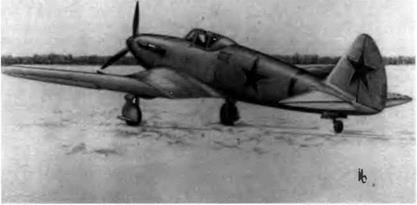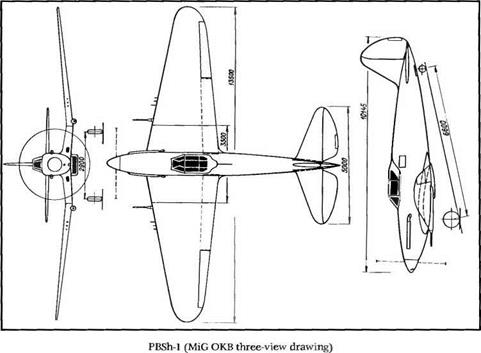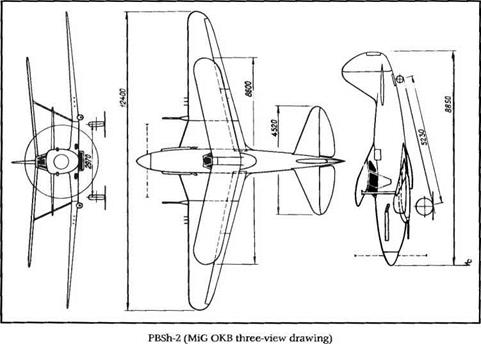PBSh-1 and PBSh-2 Series
PBSh-1
Throughout the 1930s the doctrines relating to the use of big armored units were completely reappraised. Because every new threat demanded an immediate answer, a new type of aircraft appeared in the USSR: the shturmovik, or assault aircraft. Several of the best-known aircraft manufacturers worked on this new weapon. At the start of the decade Tupolev proposed two heavy shturmoviks, the ANT-17 and ANT-18, but they were never built. The TsKB (central construction bureau) built four aircraft designed by D. P. Grigorovich, the LSh-1, TSh-1, TSh-
|
The PBSh-1 main gear was directly inspired by that of the I 200. |
2, and ShON. In 1933 a design brigade under the leadership of S. A. Kocherigin—and assisted by the forty-one-year-old M. I. Guryevich, Mikoyan’s future right-hand man—built the TSh-3, also called the TsKB-4. N. N. Polikarpov, for its part, developed the R-ZSh.
All of these attempts led in 1936 to the Ivanov program (“Ivanov” was Stalin’s cable address), an air force initiative that resulted in the construction of such prototypes as the KhAI-5 (R-10) and KhAI-52, designed by Nyeman, winner of the contest; and the ANT-51 and ShB, both designed by Sukhoi. But in the end the true winner was a relatively unknown outsider, S. V. Ilyushin. More than 40,000 of its BSh-2s, renamed the 11-2 in 1940, were built because of the war.
Mikoyan and Guryevich started the preliminary design of their first assault aircraft in 1940. The PBSh-1 (Pushechniy Bronirovaniy Shtur – movik. armored assault aircraft with cannons) was a single-seater designed to attack frontline ground targets such as troops, strong points, and armored vehicles. It had a cantilever inverted gull wing and was to be powered by a 1,178 kW (1,600 ch) Mikulin AM-38 engine. Sensitive parts, the engine, and the cockpit would be protected by armor plating. But the weight of the armor alone was 1,390 kg (3,065 pounds), or 30 percent of the aircraft’s takeoff weight. The design had tc be completely reconsidered to integrate the armor into the stressed structure. It was to be equipped with two 23-mm cannons in fairings beneath the wing (96 rpg) and six 7.62-mm ShKAS machine guns on the wing leading edge (750 rpg). All of these weapons would fire outside the propeller disc.
|
|
|
|
The bomber version of the aircraft was to carry in its fuselage either 24 10-kg (22-pound) FAB-10 or 24 8-kg (17.6-pound) FAB-8 bombs and either 280 2.5-kg (5.5-pound) FAB-2.5 or 120 1-kg (2.2-pound) ZAB – 1 bombs. (FAB indicates demolition bombs, while ZAB refers to incendiary bombs. The number after the acronym reflects the bomb’s weight.) For dive-bombing missions, two FABs ranging in weight from 25 to 250 kg (55 to 550 pounds) could be added beneath the wings.
The preliminary design by N. Z. Matyuk, chief of the aerodynamic design department, was approved on 24 July 1940 by OKO chief engineer Mikoyan, his assistant Guryevich, and P. V. Dementyev, manager of Aviakhim factory no. 1. The OKO started work on a full-scale model of the aircraft in the fall. But as soon as the Ilyushin 11-2 was approved for series production, О KB engineers halted all work on the PBSh-1 and started in immediately on the preliminary design for the PBSh-2.
In some OKB documents the PBSh-1 is referred to as the MiG-4.
Specifications
Span, 13.5 m (44 ft 3.5 in); length, 10.145 m (33 ft 3.4 in); height, 3.2 m (10 ft 6 in); wheel track, 2.9 m (9 ft 10 in); wheel base, 6.6 m (21 ft 7.9 in); wing area, 30.5 rrF (328.3 sq ft); takeoff weight, 4,850 kg (10,690 lb); max takeoff weight, 6,024 kg (13,277 lb); wing loading, 159 kg/m2 (32.6 lb/sq ft).
Design Performance
Max speed, 441 km/h at 5,000 m (238 kt at 16,400 ft); max ground speed, 449 km/h (242 kt); range, 900 km (560 mi); service ceiling, 7,600 m (25,690 ft).













